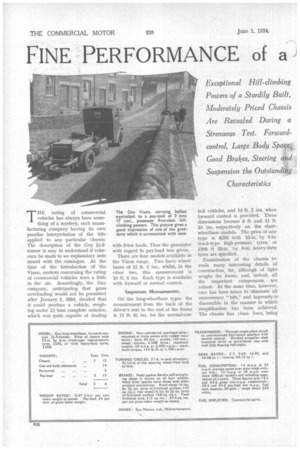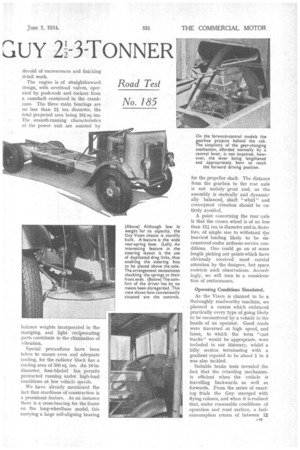FINE PERFORMANCE of a
Page 44

Page 45

Page 46

If you've noticed an error in this article please click here to report it so we can fix it.
Guy 212-3-ToNNER
Exceptional Hill-climbing Powers of a Sturdily Built, Moderately Priced Chassis Are Revealed During a Strenuous Test. Forwardcontrol, Large Body Space, Good Brakes, Steering and Suspension the Outstanding Characteristics
THE rating of commercial vehicles has always been something of a mystery, each manufacturing company having its own peculiar interpretation of the title applied to any particular chassis. The description of the Guy 21-3tonner is easy to understand if reference be made to an explanatory note issued with the catalogue. At the time of the introduction of the Vixen, matters concerning the rating of commercial vehicles were a little in the air. Accordingly, the Guy company, anticipating that gross overloading would not be permitted after January 1, 1934, decided that it could produce a vehicle, weighing under 21 tons complete unladen, which was quite capable of dealing
with 3-ton loads. Thus the guarantee with regard to pay-load was given.
There are four models available in the Vixen range. Two have wheel bases of 12 ft. 6 ins., whilst, in the other two, this measurement is 10 ft. 6 ins. Each type is available with forward or normal control.
Important Measnrements.
On the long-wheelbase types the measurement from the back of the driver's seat to the end of the frame is 11 ft. 31 ins, for the normal-con trol vehicles, and 14 ft. 2 ins, when forward control is provided. These dimensions become 9 ft. and 11 ft. 10 ins. respectively on the shortwheelbase models. The price of any type is £295 with 32-in.' b' 6-in. truck-type high-pressure tyres, or i308 if 32-in. by 6-in, heavy-duty tyres are specified.
Examination of the chassis reveals many interesting details of construction, for, although of light weight the frame, and, indeed, all the important components, • are robust. At the same time, however, care has been taken to eliminate all unnecessary "bits,' and ingenuity is discernible in the manner in which simplification has been achieved. The chassis has clean lines, being balance weights incorporated in the stamping, and light reciprocating parts contribute to the elimination of vibration.
Special precautions have been taken to ensure even and adequate cooling, for the radiator block has a cooling area of 500 sq. ins. An 18-in. diameter, four-bladed fan permits protracted running under high-load conditions at low vehicle speeds.
We have already mentioned the fact that sturdiness of construction is a prominent feature. As an instance there is a cross-bracing for the frame on the long-wheelbase model, this carrying a large self-aligning bearing
for the propeller shaft. The distance from the gearbox to the rear axle is not unduly great and, as the assembly is statically and dynamically balanced, shaft "whirl" and consequent vibration should be entirely avoided.
A point concerning the rear axle is that the crown wheel is of no less than 121 ins, in diameter and is, therefore, of ample size to withstand the heaviest loading likely to be encountered under arduous service conditions. One could go on at some length picking out points which have obviously received most careful attention by the designer, but space restricts such observations. Accordingly, we will turn to a consideration of performance.
Operating Conditions Simulated.
As the Vixen is claimed to be a thoroughly roadworthy machine, we planned a course which embraced practically every type of going likely to be encountered by a vehicle in the hands of an operator. Good roads were traversed at high speed, and lanes, to which the term "cart tracks" would be appropriate, were included in our itinerary, whilst a hilly section terminating with a gradient reputed to be about 1 in 4 was also tackled.
Suitable brake tests revealed the fact that the retarding mechanism is efficient when the vehicle is travelling backwards as well as forwards. From the series of exacting trials the Guy emerge.d with flying colours, and when it is realized that, under reasonable conditions of operation and road surface, a fuelconsumption return of between 12
m.p.g. and 14 m.p.g. can be obtained, the behaviour of the chassis must be considered entirely satisfactory.
From the works at Wolverhampton an easy route was followed to Sedgley Beacon, where a long rise up to the town had to be tackled.
Despite the load, third gear sufficed for the climb, which, in certain parts,
is steeper than 1 in 14. Leaving main roads, the cross-country section
was commenced. It 'Was noticeable on the narrow roads how readily the vehicle answered to movements of the steering wheel and responded to applications of the brake pedal.
Good Performance on Hills.
With a little trepidation the Guy was put at Moden Hill. Here, as the gradient stiffened, lower gears were successively engaged, "first" being requisitioned some little distance be fore reaching the 1-in-4 section. A faultless climb was recorded at a speed between 5 m.p.h. and 6 ra.p.h.
Having backed the vehicle down to the steepest part of the hill we made a restarting testAgain the Guy performed faultlessly, picking up its load without its being necessary to slip the clutch unduly. Checking the cooling-water temperature at the top of Moden Hill immediately after the climb showed that there was no sign of boiling. Hauliers whose main operations lie in hilly districts should, therefore, be able to use the Guy Vixen without any qualms about overheating.
On main roads we experienced no difficulty Whatever in maintaining the maximum legal limit of 30 m.p.h., for there seems to be a good margin of power in hand for acceleration and hill-climbing at reasonable road speeds. As will be seen from the acceleration graph, 30 m.p.h. can be reached from a datum of 10 m.p.h. in but 25 secs. in top gear, whillst on third gear speed can be increased at the rate of 1.5 m.p.h. per sec.—good going for an economical 3-tonner.
At all the speeds within the range the suspension is good, and, although in the forward-control chassis the driver sits almost immediately very steadily. In this respect our impressions were borne out by the fact that a number of items of equipment placed loosely in the ballast container was not seen to move.
The rear springs, it will be noticed, are outrigged from the frame, giving the widest possible base, which, in turn, means that the overturning couple when cornering is reduced so far as is practicable.
We noticed carefully the action of the chassis when negotiating sharp corners at a fast pace, but, despite the rather-high concentrated load, there was little heeling tendency. All this reacts advantageously, for it means that an uneven load will not necessarily cause trouble, whilst the fact that the control, steering, brakes, etc., operate smoothly and positively should give confidence to drivers when working under awkward road conditions.
The clutch is smooth, light to operate and free from judder when• the friction surfaces are engaged without proper care. Thanks to a light spinning member gear changing is easy and it is not necessary to pause for any appreciable time with the gear lever in neutral when changing in an upward direction. When changing down to a lower gear it is necessary to make only an approximation of the correct meshing speeds in order to obtain silent engagement.
Minor Criticisms.
Our only criticisms of this fine chassis are really of a minor nature. They concern the starter switch and the gear lever. The former component is a little inaccessible, being under the driver's seat, whilst there is a certain amount of springiness in the long gear lever which is at first a little disconcerting.
Fully equipped with a five-lamp lighting set, speedometer, spare wheel and tyre, running boards and valances, etc., this chassis is a fine value-for-money proposition. A variety of body types is available and a guarantee to haul 2 tons on a trailer, in addition to the 3 tons carried on the vehicle, is given.




































































































